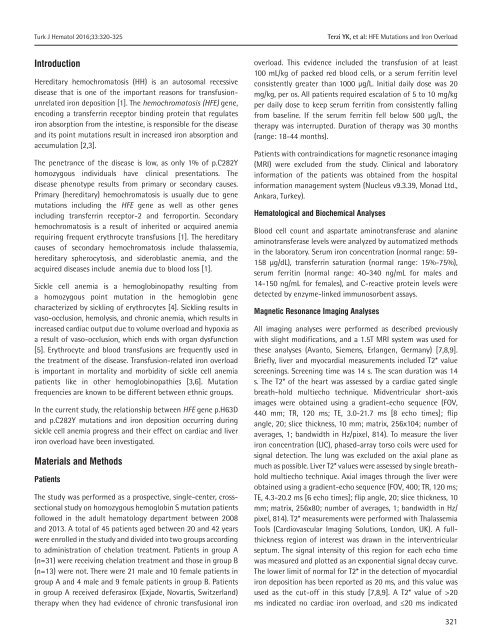Turkish Journal of Hematology Volume: 33 - Issue: 4
You also want an ePaper? Increase the reach of your titles
YUMPU automatically turns print PDFs into web optimized ePapers that Google loves.
Turk J Hematol 2016;<strong>33</strong>:320-325<br />
Terzi YK, et al: HFE Mutations and Iron Overload<br />
Introduction<br />
Hereditary hemochromatosis (HH) is an autosomal recessive<br />
disease that is one <strong>of</strong> the important reasons for transfusionunrelated<br />
iron deposition [1]. The hemochromatosis (HFE) gene,<br />
encoding a transferrin receptor binding protein that regulates<br />
iron absorption from the intestine, is responsible for the disease<br />
and its point mutations result in increased iron absorption and<br />
accumulation [2,3].<br />
The penetrance <strong>of</strong> the disease is low, as only 1% <strong>of</strong> p.C282Y<br />
homozygous individuals have clinical presentations. The<br />
disease phenotype results from primary or secondary causes.<br />
Primary (hereditary) hemochromatosis is usually due to gene<br />
mutations including the HFE gene as well as other genes<br />
including transferrin receptor-2 and ferroportin. Secondary<br />
hemochromatosis is a result <strong>of</strong> inherited or acquired anemia<br />
requiring frequent erythrocyte transfusions [1]. The hereditary<br />
causes <strong>of</strong> secondary hemochromatosis include thalassemia,<br />
hereditary spherocytosis, and sideroblastic anemia, and the<br />
acquired diseases include anemia due to blood loss [1].<br />
Sickle cell anemia is a hemoglobinopathy resulting from<br />
a homozygous point mutation in the hemoglobin gene<br />
characterized by sickling <strong>of</strong> erythrocytes [4]. Sickling results in<br />
vaso-occlusion, hemolysis, and chronic anemia, which results in<br />
increased cardiac output due to volume overload and hypoxia as<br />
a result <strong>of</strong> vaso-occlusion, which ends with organ dysfunction<br />
[5]. Erythrocyte and blood transfusions are frequently used in<br />
the treatment <strong>of</strong> the disease. Transfusion-related iron overload<br />
is important in mortality and morbidity <strong>of</strong> sickle cell anemia<br />
patients like in other hemoglobinopathies [3,6]. Mutation<br />
frequencies are known to be different between ethnic groups.<br />
In the current study, the relationship between HFE gene p.H63D<br />
and p.C282Y mutations and iron deposition occurring during<br />
sickle cell anemia progress and their effect on cardiac and liver<br />
iron overload have been investigated.<br />
Materials and Methods<br />
Patients<br />
The study was performed as a prospective, single-center, crosssectional<br />
study on homozygous hemoglobin S mutation patients<br />
followed in the adult hematology department between 2008<br />
and 2013. A total <strong>of</strong> 45 patients aged between 20 and 42 years<br />
were enrolled in the study and divided into two groups according<br />
to administration <strong>of</strong> chelation treatment. Patients in group A<br />
(n=31) were receiving chelation treatment and those in group B<br />
(n=13) were not. There were 21 male and 10 female patients in<br />
group A and 4 male and 9 female patients in group B. Patients<br />
in group A received deferasirox (Exjade, Novartis, Switzerland)<br />
therapy when they had evidence <strong>of</strong> chronic transfusional iron<br />
overload. This evidence included the transfusion <strong>of</strong> at least<br />
100 mL/kg <strong>of</strong> packed red blood cells, or a serum ferritin level<br />
consistently greater than 1000 µg/L. Initial daily dose was 20<br />
mg/kg, per os. All patients required escalation <strong>of</strong> 5 to 10 mg/kg<br />
per daily dose to keep serum ferritin from consistently falling<br />
from baseline. If the serum ferritin fell below 500 µg/L, the<br />
therapy was interrupted. Duration <strong>of</strong> therapy was 30 months<br />
(range: 18-44 months).<br />
Patients with contraindications for magnetic resonance imaging<br />
(MRI) were excluded from the study. Clinical and laboratory<br />
information <strong>of</strong> the patients was obtained from the hospital<br />
information management system (Nucleus v9.3.39, Monad Ltd.,<br />
Ankara, Turkey).<br />
Hematological and Biochemical Analyses<br />
Blood cell count and aspartate aminotransferase and alanine<br />
aminotransferase levels were analyzed by automatized methods<br />
in the laboratory. Serum iron concentration (normal range: 59-<br />
158 µg/dL), transferrin saturation (normal range: 15%-75%),<br />
serum ferritin (normal range: 40-340 ng/mL for males and<br />
14-150 ng/mL for females), and C-reactive protein levels were<br />
detected by enzyme-linked immunosorbent assays.<br />
Magnetic Resonance Imaging Analyses<br />
All imaging analyses were performed as described previously<br />
with slight modifications, and a 1.5T MRI system was used for<br />
these analyses (Avanto, Siemens, Erlangen, Germany) [7,8,9].<br />
Briefly, liver and myocardial measurements included T2* value<br />
screenings. Screening time was 14 s. The scan duration was 14<br />
s. The T2* <strong>of</strong> the heart was assessed by a cardiac gated single<br />
breath-hold multiecho technique. Midventricular short-axis<br />
images were obtained using a gradient-echo sequence (FOV,<br />
440 mm; TR, 120 ms; TE, 3.0-21.7 ms [8 echo times]; flip<br />
angle, 20; slice thickness, 10 mm; matrix, 256x104; number <strong>of</strong><br />
averages, 1; bandwidth in Hz/pixel, 814). To measure the liver<br />
iron concentration (LIC), phased-array torso coils were used for<br />
signal detection. The lung was excluded on the axial plane as<br />
much as possible. Liver T2* values were assessed by single breathhold<br />
multiecho technique. Axial images through the liver were<br />
obtained using a gradient-echo sequence (FOV, 400; TR, 120 ms;<br />
TE, 4.3-20.2 ms [6 echo times]; flip angle, 20; slice thickness, 10<br />
mm; matrix, 256x80; number <strong>of</strong> averages, 1; bandwidth in Hz/<br />
pixel, 814). T2* measurements were performed with Thalassemia<br />
Tools (Cardiovascular Imaging Solutions, London, UK). A fullthickness<br />
region <strong>of</strong> interest was drawn in the interventricular<br />
septum. The signal intensity <strong>of</strong> this region for each echo time<br />
was measured and plotted as an exponential signal decay curve.<br />
The lower limit <strong>of</strong> normal for T2* in the detection <strong>of</strong> myocardial<br />
iron deposition has been reported as 20 ms, and this value was<br />
used as the cut-<strong>of</strong>f in this study [7,8,9]. A T2* value <strong>of</strong> >20<br />
ms indicated no cardiac iron overload, and ≤20 ms indicated<br />
321

















